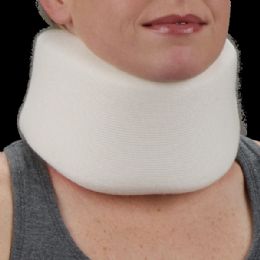














What are the main uses for cervical collars and associated devices?
Sometimes known as neck braces, cervical collars are designed to support the cervical spine in a neutral position, to limit head movements and/or to immobilize the cervical spine. Emergency personnel use cervical collars to immobilize patients who may have traumatic head or neck injuries, which could result in cervical fractures. Even small cervical fractures put patients at high risk for spinal cord injury.
An example of this type of injury would be a person suspected of having whiplash caused by a car accident. EMT professionals may place a collar on such patients for extrication to immobilize the cervical spine and limit head movements. The collar may remain in place until X-rays can be taken to confirm whether or not a cervical spine fracture exists. Unrestrained movement of the injured person could otherwise exacerbate the injury, leading to paralysis or death.
The devices designed for use by EMTs may include a large trachea opening, which is useful for monitoring the carotid pulse and performing airway procedures such as emergency tracheotomy. Such an opening is also useful for performing airway procedures following a tracheotomy, for those who are recovering from cervical trauma at home.
Cervical collars also may be used therapeutically to relieve pain from head movements and to help realign the spinal cord, or to support the neck during post-surgical recovery after a cervical spinal fusion. They are often used for patients with strains, sprains or whiplash. Other conditions for which cervical collars may be prescribed include cervical arthritis, mild muscle weakness, cervical facet syndrome, disc displacement, degenerative disc disease (with or without radiculopathy), discogenic pain, and following any cervical trauma.
Cervical collars generally are not worn for long periods of time, though if pain is persistent the collar may be required throughout the healing process. Studies have shown that long periods of neck immobility can decrease muscle strength and weaken recovery.
Use is generally restricted to no more than three hours at a time during the first week after injury, when patients experience more severe pain. Recommendations for the use of a cervical collar may vary, and your doctor may recommend use of a collar if it helps you sleep at night.
What types of cervical collars exist?
There are various types of cervical collar products, designed and sized for use with patients from infants to adolescents to adults. Soft support collars that are fairly flexible are made from different densities of foam. Collars intended to provide more rigid support are made from stiff, high-density plastics with foam linings.
Soft foam cervical collars are the least limiting, but they carry a higher risk of further cervical breakage, especially in patients with osteoporosis. They may be used for minor injuries, to decrease the pain of awkward neck positions, or in the later stages of a phased recovery process after healing results in the neck becoming more stable.
There is also a range of rigid collars available, generally comprising a firm plastic bi-valve shell. They are secured with Velcro straps (often offering “one size fits all” adjustability) and include removable and washable padded liners. Malibu, Miami J, and Philadelphia collars are among the most frequently prescribed, and can be used with additional chest and head extension pieces to increase stability. Rigid collars are prescribed for the early stages of recovery from more serious injury or surgery.
You should consult with your physician to select the appropriate type and size of cervical collar, especially in the presence of post-operative swelling and dressings.
What other treatments might your doctor prescribe?
Medical doctors might prescribe non-steroidal anti-inflammatory medications (NSAIDs) such as aspirin or ibuprofen to decrease pain and swelling. For minor cervical fractures, immobilization accomplished with a cervical collar may be sufficient to allow healing to occur. More serious injuries may require traction and/or surgery to stabilize the neck and relieve pressure on the spinal cord.
The goal of treatment is to return you to normal activities as quickly as possible. Your doctor may recommend pain management treatments such as the application of ice or heat along with prescription painkillers, muscle relaxants, injections of numbing medications or over-the-counter drugs.
Once your pain is under control, and healing is underway, your doctor is likely to prescribe a series of exercises to help restore strength and a normal range of motion in your neck so that you can resume normal activities.
Your doctor may also refer you to a physical therapist to help with range-of-motion exercises, or if you are experiencing chronic pain due to whiplash. The therapist may introduce additional exercises to improve posture and strengthen muscles to restore normal movement. Your therapist can create a customized exercise routine to help achieve the goal of resuming normal activities so that eventually you can do so independently at home.
Rehabmart offers a variety of choices to meet patients’ needs and promote recovery throughout the healing process, whether short- or long-term. As always, work with your medical professionals to select the right products to meet those needs.
Rehabmart carries a large assortment of superior quality cervical collars (including soft cervical collars, Philadelphia Collars, neck braces and Miami J Collars) from notable vendors such as Bird & Cronin, Inc., DeRoyal, Independence Medical, United Surgical, Norco, Optec USA, and Chattanooga.
Hulet Smith, OT
Rehabmart Co-Founder & CEO
nrb